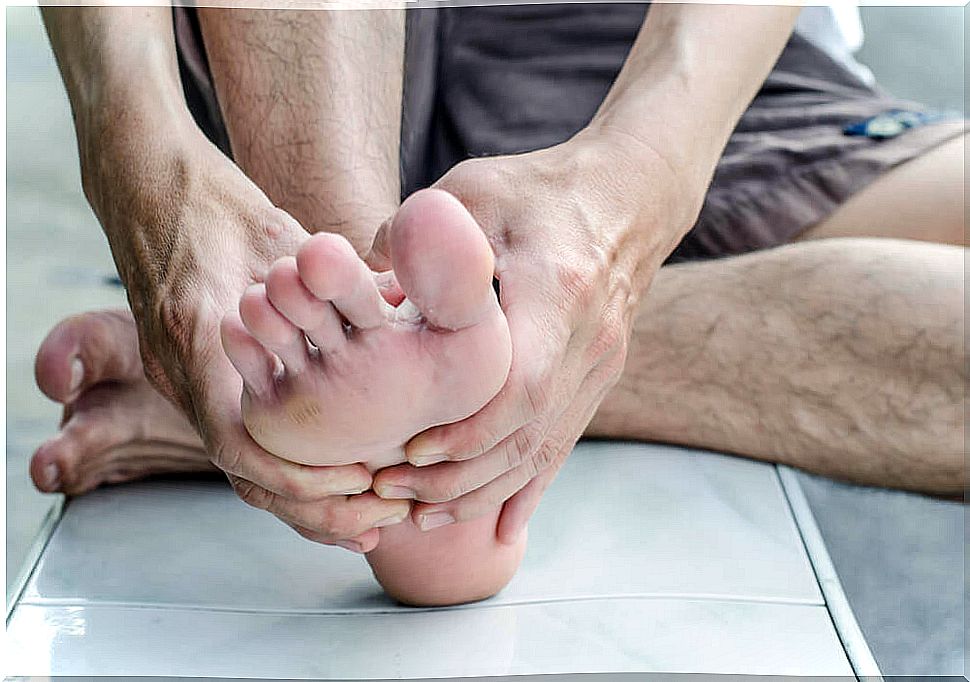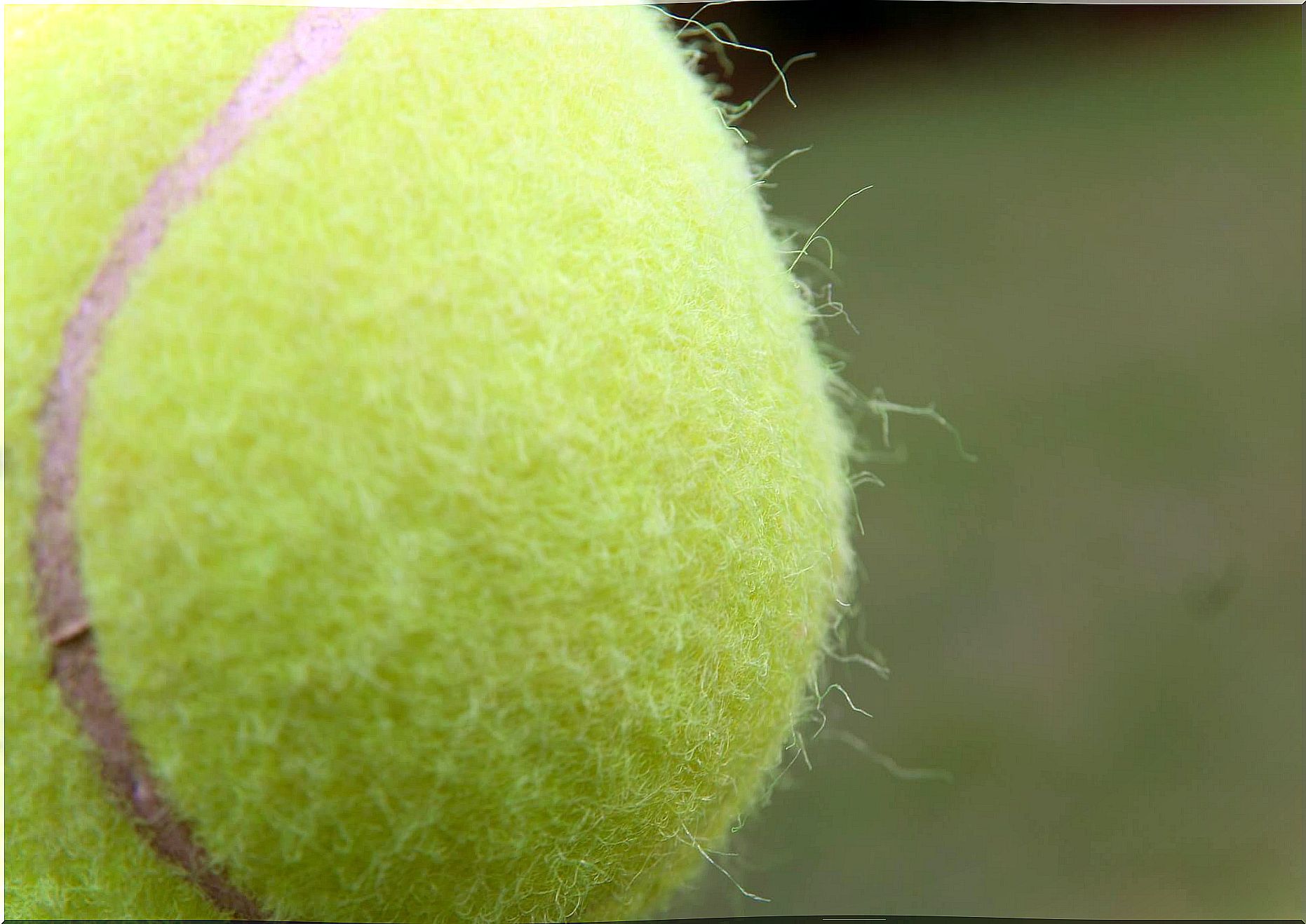How To Soothe Plantar Fasciitis With A Tennis Ball
Feeling pain in the sole of the foot is really limiting and annoying. Faced with this problem, do you know how a simple tennis ball can help you?

Few conditions can be as annoying to everyday life as pain in the sole of the foot. As we are generally wearing shoes, it is an area that is difficult to reach to massage or stretch it. That is why soothing plantar fasciitis is a priority for many people.
The plantar fascia is a thick band of tissue that connects the calcaneus to the toes and creates the arch of the foot. One of its functions is to tighten the base of the foot to cushion the impact when walking. Fasciitis occurs when the fascia becomes inflamed and causes a lot of pain.
Inflammation of the fascia can be caused by either overuse, poor stretching, or poorly supported shoes. It is also common among overweight and obese people, since the overexertion involved in supporting it generates microtrauma in their tissues.
According to an article published by Clinical Research , most cases occur in adults between 40 and 70 years of age, but it can also occur in some younger people with a certain predisposition, including the practice of certain sports in which there are repetitive impacts on the soles of the feet.
Symptoms and treatment of plantar fasciitis

Its main symptom is pain in the sole of the foot or the heel, although it sometimes spreads to the ankle and toes. Treatment is based on the consumption of analgesics and anti-inflammatories, physical therapy or, in the most serious cases, surgery, as detailed in an article in the MSD Manual.
How to use a tennis ball for plantar fasciitis?
The measures detailed above can be supplemented with some stretching exercises. These can be done with a tennis ball, which helps relax and strengthen the affected muscles.
It is important to note that, in addition to being an element used by many physiotherapists, there are also scientific studies that support the effectiveness of this technique to relieve physical discomfort. For example, one published in 2017 claims that it can decrease shoulder and neck pain immediately.
Remember, however, that it is normally used as a complement to other measures that must be indicated by the professional. Below, we share them in detail so that you do not hesitate to practice them if you feel any kind of discomfort.

Rolling massage
Rotating the feet with a tennis ball is one of the most recommended therapies to rehabilitate and calm plantar fasciitis. This movement offers self-control stretching and massage to reduce tension on the plantar fascia. How to do it?
- First, sit in a chair with your back straight.
- Next, place the sole of your foot on the tennis ball.
- Apply gentle pressure to it. Pushing the foot towards the ground and making movements from front to back, from the toes to the heel.
- Roll the ball for 30 seconds and repeat the activity with the other foot.
- You can repeat this activity several times a day, according to the recommendation of the physiotherapist, until the pain subsides.
Flexion
To enhance the strength of the feet and improve their support, it is convenient to perform exercises that work the flexibility of both muscles and tendons. The following activity helps you relax and soothe plantar fasciitis, but it can also help strengthen the sole of your foot, ankle, and legs.
- First, place the tennis ball against a wall and do a push-up stretch.
- Next, bring the ball to the top of your foot, keeping your heel flat on the floor.
- Then, lean your upper body toward the wall to increase the stretch.
- Take three slow breaths, rest and repeat it as many times as the physiotherapist advises you.
Relaxation stretch
With this relaxation activity, work of breathing is combined with pressure on stressed areas to soothe plantar fasciitis. In addition, it serves to reactivate blood circulation – as demonstrated in a 2004 study that analyzed the effect of massage on the lower back – and reduce inflammation.
With the pressure we exert on the ball, we massage the soft areas of the foot. This contributes because it provides relief. It is done as follows:
- First, take off your shoes and stand with one foot forward, resting on the ball.
- Next, step on the pad between the arch of your foot and your toes. Leave your body weight on your back leg.
- Maintaining this posture, take a breath and release it, while putting the weight on the front foot.
- Then bend your knee a little, hold for five seconds, and put your weight back on your back leg.
- Repeat the activity with both feet, until completing five repetitions with each one.
Pressure point
Pressure point exercises focus on relaxing any of the muscles in the bottom of the foot. With these, we can place the ball just below the area where the pain is concentrated, and thus calm plantar fasciitis.
- First, put the tennis ball under the ball of the foot – where the toes meet the rest of the foot – and press firmly for 10 seconds.
- Then shift the ball to the top or bottom of your foot and repeat.
- Try to start at the points that are near the base of the toes. Then slowly roll the ball to your heel.

Comprehensive treatment to calm plantar fasciitis
As you can see, a simple ball can become a very good tool to exercise and strengthen your feet. If you suffer from plantar fasciitis or feel pain or fatigue, do not hesitate to use it as a complement to the treatment indicated by the professional.
Also in case of injury, bunions or corns, these types of activities can cause a feeling of relief while fighting with other treatments. In all cases, try to follow each of the specialist’s instructions to solve the problem as soon as possible.








